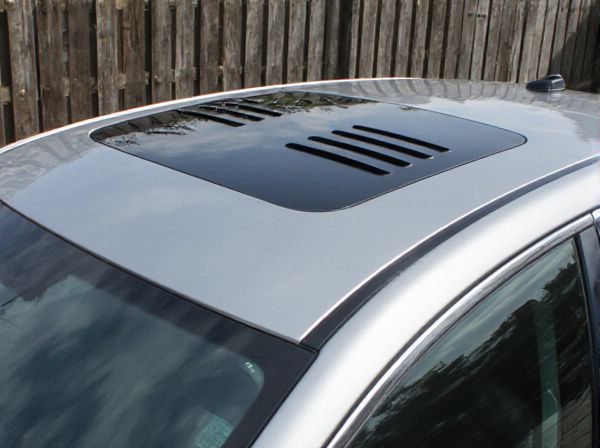
Photo illustration: Louvered Roof vs Smooth Roof
A louvered roof offers adjustable slats that control sunlight and ventilation, enhancing outdoor comfort and energy efficiency. Smooth roofs provide a sleek, seamless surface that excels in waterproofing and minimal maintenance. If you seek versatility in shading and airflow, a louvered roof is ideal, while a smooth roof suits those prioritizing durability and easy upkeep.
Table of Comparison
| Feature | Louvered Roof | Smooth Roof |
|---|---|---|
| Design | Adjustable slats for airflow and light control | Seamless, flat surface for sleek appearance |
| Ventilation | Excellent, allows customizable ventilation | Limited, usually fixed or no vents |
| Weather Protection | Good, with water drainage features | High, fully sealed against elements |
| Maintenance | Requires periodic cleaning and louver adjustment | Low maintenance, easy to clean surface |
| Weight | Moderate, slightly heavier due to mechanism | Lightweight, simpler structure |
| Noise Levels | Potential wind noise when open | Quieter, solid surface reduces noise |
| Cost | Higher initial cost due to complexity | Generally lower cost, simpler design |
Introduction to Louvered and Smooth Roofs
Louvered roofs consist of adjustable slats that control sunlight and ventilation, providing a dynamic outdoor environment. Smooth roofs feature a flat, seamless surface designed for weather resistance and low maintenance. Understanding the benefits of each roof type helps in selecting optimal solutions for comfort and durability in residential or commercial spaces.
Key Differences Between Louvered and Smooth Roofs
Louvered roofs feature adjustable slats that allow for precise control of sunlight and ventilation, enhancing outdoor comfort and energy efficiency, whereas smooth roofs consist of fixed, solid panels offering consistent protection from rain and sun but limited airflow. The key difference lies in functionality: louvered roofs provide adaptability for dynamic weather conditions, while smooth roofs prioritize simplicity and durability. Material options also vary, with louvered roofs commonly made from aluminum or steel for strength and corrosion resistance, and smooth roofs often utilizing polycarbonate or metal sheets for a sleek, low-maintenance surface.
Design and Aesthetic Appeal
Louvered roofs offer a dynamic design with adjustable slats that create a modern, sleek aesthetic while allowing control over light and ventilation, enhancing outdoor living spaces. Smooth roofs provide a clean, minimalist appearance with continuous surfaces that complement contemporary architectural styles and require less maintenance. Both designs can be customized with various materials and finishes to match specific aesthetic preferences and functional needs.
Functionality and Flexibility
A louvered roof offers adjustable slats that control sunlight, ventilation, and rain protection, providing superior flexibility for outdoor spaces. Smooth roofs provide consistent, solid coverage ideal for full weather protection but lack the adaptability of adjustable panels. Functionality in louvered roofs centers on customizable airflow and shading, while smooth roofs emphasize durability and uniform shelter.
Durability and Weather Resistance
Louvered roofs feature adjustable slats made from durable materials like aluminum, offering superior weather resistance by allowing ventilation and protection against rain and UV rays. Smooth roofs, often constructed from materials such as rubber or metal, provide a seamless surface that resists water penetration but may lack the airflow benefits of louvered designs. The choice between louvered and smooth roofs depends on climate demands and maintenance preferences, with louvered roofs excelling in adaptability and smooth roofs in solid, uninterrupted coverage.
Energy Efficiency and Ventilation
Louvered roofs offer superior ventilation by allowing adjustable airflow, reducing indoor temperatures and lowering cooling energy consumption compared to smooth roofs. Smooth roofs, typically flat and sealed, often trap heat, leading to higher reliance on air conditioning systems and increased energy costs. Optimizing ventilation through louvered roofing systems enhances natural cooling, thereby improving overall energy efficiency in residential and commercial buildings.
Installation and Maintenance Requirements
Louvered roofs require precise installation to ensure movable slats are aligned for optimal ventilation and weather protection, often taking longer to install compared to smooth roofs. Smooth roofs have a simpler installation process, typically involving fewer components and less mechanical assembly. Maintenance for louvered roofs involves regular cleaning and lubrication of the slats to prevent jamming, whereas smooth roofs primarily require routine inspections for debris and potential water pooling.
Cost Comparison: Louvered vs Smooth Roof
Louvered roofs typically cost more upfront than smooth roofs due to their adjustable slat mechanisms and durable materials, with prices ranging from $1,200 to $3,500 per square meter compared to $800 to $2,200 for smooth roofs. The maintenance costs of louvered roofs can be higher because of moving parts requiring regular servicing, while smooth roofs have simpler designs leading to lower upkeep expenses. Long-term energy efficiency of louvered roofs often offsets higher initial costs by improving ventilation and shading, reducing cooling expenses relative to smooth roofs.
Best Applications for Each Roof Type
Louvered roofs are ideal for outdoor spaces requiring adjustable light and ventilation control, such as patios, pergolas, and poolside areas, offering versatility in weather management. Smooth roofs, often constructed from materials like metal or single-ply membranes, excel in commercial buildings and residential flats where a sleek, waterproof, and low-maintenance surface is essential. Both roof types provide specific benefits: louvered roofs enhance outdoor comfort with flexible shading, while smooth roofs prioritize durability and ease of installation in environments demanding consistent protection from the elements.
Choosing the Right Roof for Your Needs
Selecting between a louvered roof and a smooth roof depends on your climate control and aesthetic preferences. Louvered roofs offer adjustable slats for ventilation and sunlight control, ideal for outdoor spaces needing versatility. Smooth roofs provide a sleek, uniform appearance with superior weather protection, suited for areas prioritizing durability and minimal maintenance.
 caratoz.com
caratoz.com